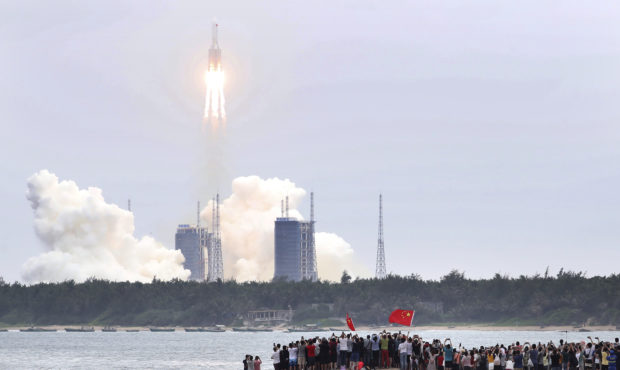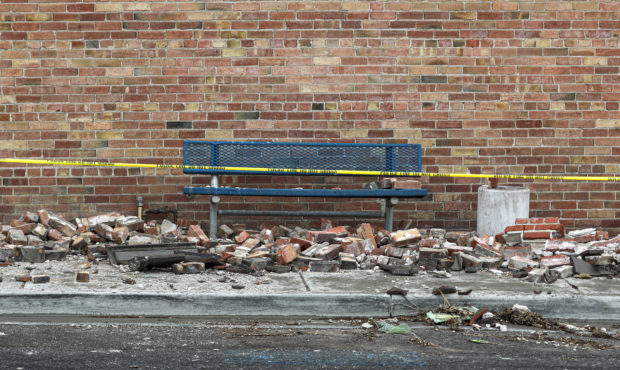Dave & Dujanovic: Chinese rocket falling back to Earth, but space expert says don’t worry
May 6, 2021, 3:20 PM | Updated: 3:37 pm

In this photo released by China's Xinhua News Agency, a Long March 5B rocket carrying a module for a Chinese space station lifts off from the Wenchang Spacecraft Launch Site in Wenchang in southern China's Hainan Province, Thursday, April 29, 2021. China has launched the core module on Thursday for its first permanent space station that will host astronauts long-term. (Jin Liwang/Xinhua via AP)
(Jin Liwang/Xinhua via AP)
SALT LAKE CITY — Heads up: A failing Chinese rocket flying through space at 18,000 mph in a decaying orbit is coming back home to Earth in a hurry, and no one knows where it will land.
Debris from the 22-ton, 98-feet-long rocket is expected to crash back to Earth on Saturday.
China’s Long March 5B rocket is “unpredictably” falling back to Earth after launching a part of the new T-shaped Chinese space station on Thursday in Wenchang, according to SpaceNews.
Chinese rocket coming down
Patrick Wiggins, NASA ambassador for Utah, joined Dave Noriega and Debbie Dujanovic to provide some details, especially the part about it flying over Utah every 90 minutes.
Wiggins started by correcting a false statement that has been orbiting around this news story.
“Nothing this large has fallen back to Earth in our lifetime,” said Drew Coffman on TikTok.
“In 1979, the United States Skylab at almost 80 tons came hurdling back to Earth. Parts of it landed in Australia. I’m happy to say I’ve actually got a piece […] that somebody gave me,” Wiggins said.
So there.
Remember Earth is mostly water (71%)
Wiggins said most of the areas where the debris is likely to land are either uninhabited or covered in water. He also advised not to sweat it.
“We’ve got about a week or so until Tax Day, so worry about that if you want to worry about something,” Wiggins said.
The rocket passes a little farther north than cities at about 40 degrees north latitude, including New York City, Madrid and Beijing and passes as far south as southern Chile and New Zealand, according to EarthSky.
Salt Lake City is located at 40.7 degrees north latitude. Right inside the drop zone.
“It flies right over Utah several times today and tomorrow and the next day,” Wiggins said.
“Did you just say this is flying over Utah several times a day?” Dave asked.
“Oh, yeah,” he said.
“Can I see this with the naked eye or do I need a special telescope, Patrick?” Debbie asked.
“This particular rocket seems to be out of control and tumbling. And as it tumbles across the sky, it’s brighter sections will shine light down towards us, but then it tumbles and it’s darker area is exposed, and hence, unlike the space station that we watched sometimes that’s a nice constant light going across this guy, this is going bright, faint, bright, faint,” Wiggins said. “So, we may see it, we may not. I just don’t know at this point.”
The tumbling rocket will begin to hit more and more air molecules; that resistance will start to bring it closer to Earth as it falls out of orbit and gravity begins to take over.
“If I could be guaranteed a safe vantage point, I would love to see this thing hit the atmosphere. It’s going to put on a light show like you’ve never seen before,” Wiggins said. “Fortunately, the vast majority is going to burn out before it gets to the ground.”
Read this, too:
Mysterious lights appeared over Utah skies last night
Dave & Dujanovic can be heard weekdays from 9 a.m. to noon. on KSL NewsRadio. Users can find the show on the KSL NewsRadio website and app, a.s well as Apple Podcasts and Google Play.













